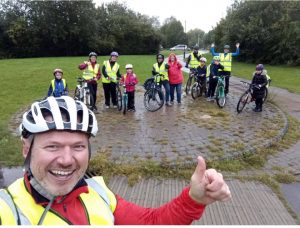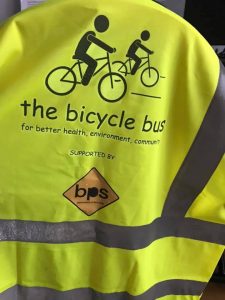Guest post by Dawn Rahman, who has just started a PhD with the ATA.
Currently in the UK only two per cent of journeys to school are undertaken by bicycle, with most parents feeling that cycling on the school run is too risky. Can safety in numbers convince more parents to switch to two wheels? If so, is a formalised and risk-assessed “bike bus” part of the answer?
Although not a new concept, several new bike bus routes have recently been launched in the UK. A bike bus is a simple concept: parents and pupils ride to school together on a set route with designated stops along the way where they can pick up more pupils.
I have w atched with interest as two bike buses have recently been set up in my local area. The first, the St Augustine School Cycle Bus was launched in October 2019 in Kenilworth by local parents Aurelie and Adam Tranter – coincidentally Adam became the first Bicycle Mayor of Coventry in February 2020. Catalysts for the bike bus included the absence of safe cycling infrastructure in the area surrounding the school and of course the various benefits that arise from more children and parents cycling on a regular basis.
atched with interest as two bike buses have recently been set up in my local area. The first, the St Augustine School Cycle Bus was launched in October 2019 in Kenilworth by local parents Aurelie and Adam Tranter – coincidentally Adam became the first Bicycle Mayor of Coventry in February 2020. Catalysts for the bike bus included the absence of safe cycling infrastructure in the area surrounding the school and of course the various benefits that arise from more children and parents cycling on a regular basis.
The organisers admit planning the scheme has at times been problematic. In addition to gaining support from the school community, local councillors and the Highways department, agreeing on a safe route, finding volunteers, undertaking Ride Leader training and getting DBS checks has all been time consuming. But it has arguably been a worthwhile endeavour as, pre-Covid, the weekly St Augustine School Cycle Bus regularly saw 20+ children and their parents take part!
Indeed, the time and dedication required to organise schemes such as these, almost always by volunteer parents, is perhaps one of the reasons why they are not more widespread. The second bike bus in my area (Warwick Gates/Whitnash) began on 2nd October. However, this was not before local parent and volunteer Simon Storey had gone through a long checklist of requirements in order to be able to launch it. Simon had attended an online seminar organised by British Cycling on the steps needed to set up a successful bike bus. Adam Tranter (of the St Augustine scheme) was one of the key speakers at this seminar, providing a useful list of dos and don’ts.
After the seminar, Simon booked himself on British Cycling’s Ride Leader course, galvanised a group of volunteer parents, set up a route and garnered local business support to provide funding for a website, hi-vis tabards as well as discounts at a local bike shop for participants of the bike bus. In both cases, it is clear that, without the dedication and determination of the volunteer organisers, these schemes would just not be able to operate.
I was able to participate in the Warwick Gates/Whitnash bike bus on its first run. The route serves three local primary schools in the area, all within half a mile of each other. Unfortunately, heavy rain on that morning resulted in slightly fewer participants than hoped for. Nevertheless, the bike bus weaved its way through a mixture of segregated cycle paths, and one very busy main road, before then turning onto quieter streets close to the three schools. As expected, the quieter streets were full of parked cars from the school run which made navigating the narrow roads close to the school

difficult at times, particularly for those children not used to cycling on the road.
On reaching the school gates, the bike bus generated some interest from other parents who hadn’t known about it and are now keen to participate in the next one. Although I’m not a fan of cyclists being made to wear hi-vis clothing, the provision of branded “Bike Bus” vests was perfect for this particular situation. It both acted as an advert for the bike bus, and signalled to drivers that we were riding as a group.
In conclusion, my views on bike buses are that they are a great initiative, though not without some issues. Given their dependence on the commitment of volunteers, if an organiser’s personal situation changes, for instance their children move onto secondary school, they change jobs etc, a whole scheme could be in jeopardy. Additionally, in the absence of safe segregated cycle infrastructure or other measures to control speed and parking issues close to schools, those cycling on roads (even in a group) can sometimes feel unsafe and rely on those driving to do so considerately.
On a positive note, bike buses give parents who may previously have been reluctant to cycle to school (due to safety concerns) the opportunity to feel safer as part of an organised group riding together. Furthermore, by getting parents/pupils used to the route to school, this will hopefully lead to their feeling comfortable enough to undertake the journey on days when the bike bus isn’t operating. Similarly, the more people take part in these organised sessions, the more this raises awareness of cycling as a viable mode of transport to schools, perhaps encouraging those parents who’ve never previously thought about cycling to consider it. Finally, and perhaps most important, the children LOVE cycling to school and that is what it’s all about!
Links:
http://staugustinescyclebus.co.uk
- School Streets: ATA podcast 2024:2 - July 1, 2024
- Accessibility and Urban Design: ATA podcast 2024:1 - January 25, 2024
- Queering Cartographic Methods: ATA podcast 2023:4 - July 6, 2023